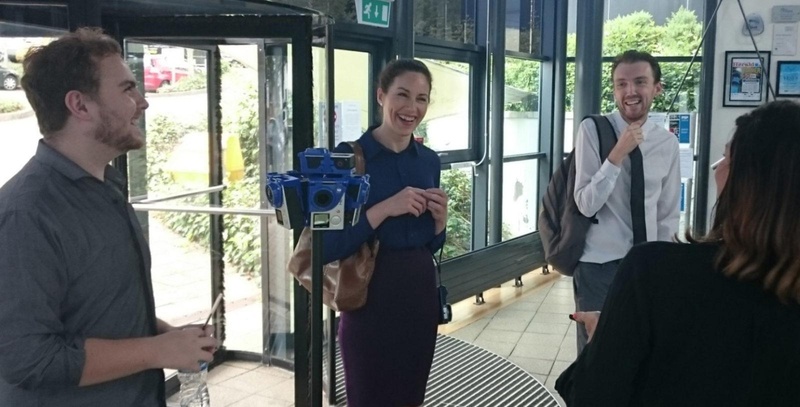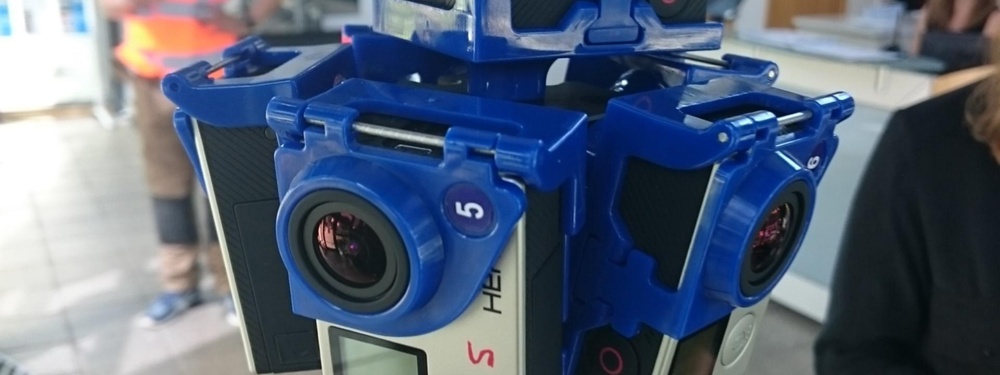A day in the life of a VR script writer: Top takeaways

Top takeaways
Oculus Rift and Google Cardboard. If you’d asked me about VR a month ago, these are the only two things I would have talked about.
It’s been an enlightening few weeks.
As a brief introduction to the project, Sponge has been creating a VR learning experience to help security personnel counter hostile reconnaissance, the information gathering phase of a planned malicious attack. The experience involves the learner observing an environment to identify suspicious behaviour, then conducting a resolution conversation with those they deem to be suspicious, and ultimately deciding whether or not to escalate the situation.
I’m no stranger to scriptwriting and film shoots, but there was one key difference that that dictated almost every part of production: A 360° camera sees in all directions. Think six little cameras taped around a pole.

Nowhere to hide
Director Alejandro González Iñárritu delivered an incredible cinematic feat by hiding his cuts in Birdman to make it look like a feature-length single shot. Despite the skill required to achieve this, if the runner in Birdman spilled coffee behind the camera, the shot could still be saved.
In a 360° film shoot there is nowhere to hide! If the runner spills the coffee in a 360° shoot, they’re in frame, and the entire take needs to be re-done. When filming our 3-minute-long ambient take, we couldn’t afford for anything to go wrong, but there was one key problem: We were filming in an uncontrollable space with members of the public.
During filming, we had people looking directly into the camera (not so much an issue given the camera acted as the point of view for the learner). However, shouting ‘are we being filmed?’ was a problem, one that ended the take, required the cameras to be re-set, and meant all of the actors had to once again play out their tightly timed and choreographed entrances. For each new take we crossed our fingers that nothing would go wrong (mentally, not physically, because the camera would see that too).
And largely, nothing did, which is incredible given we had to subtly hide our actors’ entrance cues with stopwatches and a disguised cough was the cue for ‘yes, you need to walk into the room now.’
The thing with 360° video is that while the camera can see everything, you as the filmmaker can’t see anything. At least, not until you’ve downloaded the footage onto a computer from the camera, and with the 400-something gigabytes of footage we ended up with, that takes a while. There was every chance that none of the many takes would work, and we’d be left with unusable footage. Also, because you’re always in shot, it was next to impossible to subtly direct, or even see what was going on, if the actors were doing what they were supposed to be doing, and if the runner had spilled the coffee.
"The thing with 360° video is that while the camera can see everything, you as the filmmaker can’t see anything."
Kieran Rae, Graduate Content Writer at Sponge.
But there was much more to this project than just the shoot. Sparkworks, the Innovation Team at Sponge aren’t just driven by showing the world the latest technologies, but endeavour to transform them into memorable learning experiences through exciting narrative and storytelling. Scripting the characters’ backstories so they all overlap and painting an authentic picture was integral to creating a compelling learning environment where users are the main character. Scripting the three minute ambient scene with red herrings, timed actions and even the behaviour of the characters was important to make the experience challenging – and success even more rewarding.
Post-production was interesting too. Largely dictated by the flow of the piece, the structure of the experience was tweaked continuously, balancing feedback with interactivity for maximum engagement. Seeing the production brought to life with interactions on screen and finally, in the headset, made me realise my key takeaway from this project.
Even though 360° VR presents its challenges, it’s a thoroughly impressive, effective and rewarding experience, both for the learner and the creators. It opens potential for the future. As a team effort, working with innovation, development, design and the project coordinators was inspiring and summed up what ultimately made this project a success; creative brains coming together to push the boundaries and make something new.